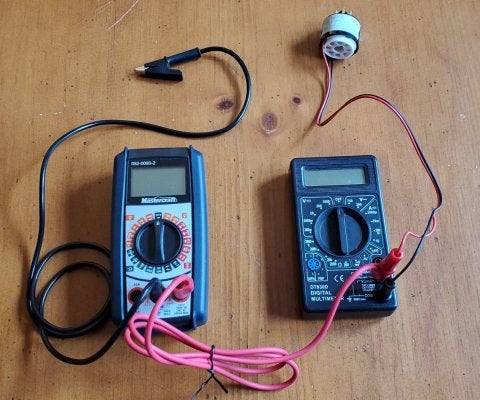Al up north
TDPRI Member
Greetings,
This is my first post but I've read and enjoyed this forum for years mostly for the guitar stuff but I do want to try biasing my amp on my own (1999 Fender DRRI). I think I need new tubes as I'm not getting any sound out of the amp. I have a new matched pair of JJ 6V6s and I thought I might try putting them in and biasing the amp myself.
I'm aware of the dangers so I wanted some opinions first. I intend to connect everything with the amp off and set the meters to the correct measurement settings before turning on my amp.
so I wanted some opinions first. I intend to connect everything with the amp off and set the meters to the correct measurement settings before turning on my amp.
I was inspired by the video linked below from Guitologist on youtube where he measures plate voltage and current at the same time using two meters (see time stamp 10:00).
To summarize, Guitologist makes a similar bias probe and leaves the soldered joint on pin 3 of the tube exposed. He sets up a second meter clipping the live end to the exposed pin 3 connection and the other to ground.
My setup is similar - the bias probe is one from Nobsound that reads the plate current from pin 3. The meter on the left in setup to read plate current (I hope) and is connected to pin 3 via the piggy back lead and to ground (amp chassis) via the black aligator clip. The meter on the right will read current for biasing the amp.
Once I know the plate voltage I'll use the calc: watts ÷ plate voltage x 70% to achieve my bias current setting/target.
Will this setup work to read plate voltage?
Thank you,
Al
This is my first post but I've read and enjoyed this forum for years mostly for the guitar stuff but I do want to try biasing my amp on my own (1999 Fender DRRI). I think I need new tubes as I'm not getting any sound out of the amp. I have a new matched pair of JJ 6V6s and I thought I might try putting them in and biasing the amp myself.
I'm aware of the dangers
I was inspired by the video linked below from Guitologist on youtube where he measures plate voltage and current at the same time using two meters (see time stamp 10:00).
To summarize, Guitologist makes a similar bias probe and leaves the soldered joint on pin 3 of the tube exposed. He sets up a second meter clipping the live end to the exposed pin 3 connection and the other to ground.
My setup is similar - the bias probe is one from Nobsound that reads the plate current from pin 3. The meter on the left in setup to read plate current (I hope) and is connected to pin 3 via the piggy back lead and to ground (amp chassis) via the black aligator clip. The meter on the right will read current for biasing the amp.
Once I know the plate voltage I'll use the calc: watts ÷ plate voltage x 70% to achieve my bias current setting/target.
Will this setup work to read plate voltage?
Thank you,
Al


